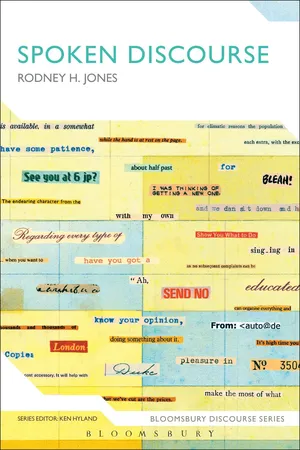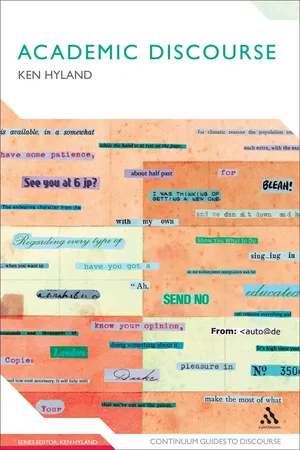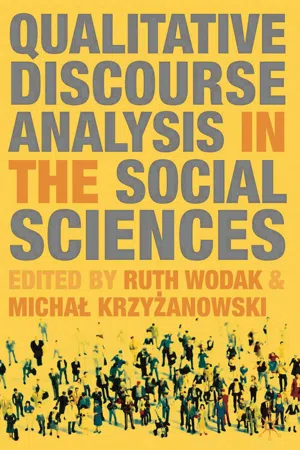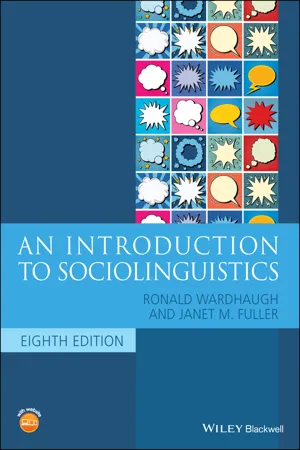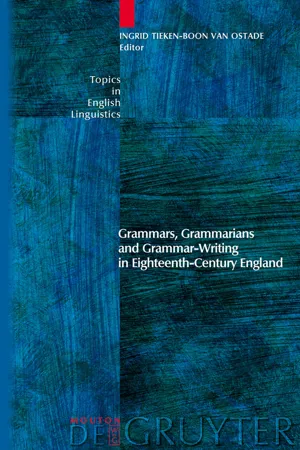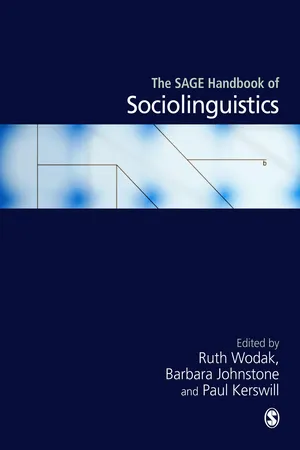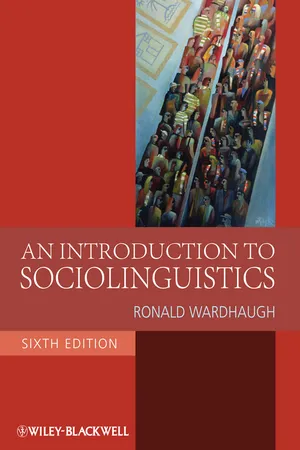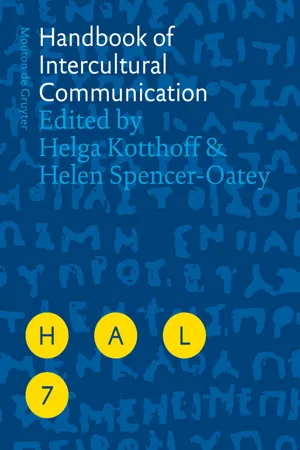Languages & Linguistics
John Swales Discourse Communities
John Swales' concept of discourse communities refers to groups of people who share common goals, interests, and ways of communicating within a particular field or area of study. These communities have their own specialized language and norms, and they play a crucial role in shaping the discourse and practices within their respective fields. Swales' work has been influential in understanding how language is used within specific professional and academic contexts.
Written by Perlego with AI-assistance
Related key terms
1 of 5
10 Key excerpts on "John Swales Discourse Communities"
- eBook - PDF
- A. Suresh Canagarajah(Author)
- 2002(Publication Date)
- University of Pittsburgh Press(Publisher)
9 Using this perspective to understand the discourse community, we can discern finer distinctions within the sociolinguistic speech community. The discourse community cuts across speech communities: physicists from France, Korea, and Sri Lanka could belong to the same discourse commu-nity, though they may belong to three di ff erent speech communities. On the other hand, within the same speech community there could be many discourse communities: thus there are specialized groups such as physicists, philosophers, and poets within the Ja ff na Tamil speech community. Such an orientation raises certain di ffi cult questions about the intra-and intergroup relations of the discourse community. To focus on intra-group constitution first, we can consider Swales’s ( ) definition of dis-course community. He lists the following as characteristics of the discourse community ( – ): . A discourse community has a broadly agreed set of common public goals. . A discourse community has mechanisms of intercommunication among its members. . A discourse community uses its participatory mechanisms primarily to provide information and feedback. . A discourse community utilizes and hence possesses one or more genres in the communicative furtherance of its aims. . In addition to owning genres, a discourse community has acquired some specific lexis. . A discourse community has a threshold level of members with a suitable degree of content and discoursal expertise. The definition broadly identifies some of the mechanisms necessary to ensure channels of communication between members as they work col-laboratively on common interests. But such definitions have a bias toward Communities of Knowledge Construction 63 cohesion and harmony. They don’t consider sources of internal tension in the community. - eBook - PDF
- Rodney Jones(Author)
- 2016(Publication Date)
- Bloomsbury Academic(Publisher)
Discourse communities Whereas speech communities are imagined around linguistic varieties and styles, discourse communities are imagined around genres, forms of language associated with different spheres of human activity. The term discourse community was coined by the applied linguist John Swales to describe groups of people who are united by a particular communicative agenda – a collection of things they want to get done with words – as well as a collection of genres designed to help them do those things. Although Swales was mainly concerned with written communication, spoken discourse, as I pointed out in Chapter 3, also has a wide variety of genres associated with it – some more general, such as stories and jokes, and others associated more specifically SPOKEN DISCOURSE 170 with particular communities, such as ‘coming out stories’ – that function in the same way the written genres that Swales described do, providing the means for groups of people with the same goals to achieve those goals. Although genres, and specifically for our purpose, speech genres, are usually thought of as particular forms of discourse defined by their structure, the most important thing about them is that they are ‘forms of action’ which are organized around ‘moves’ (Bhatia 1993). Swales (1990: 24–7) says there are six features that characterize a discourse community: (1) it has a ‘broadly agreed set of common public goals’, (2) it has ‘mechanisms of intercommunication among its members’, (3) it has ‘mechanisms … to provide information and feedback’, (4) ‘it possesses one or more genres in the communicative furtherance of its aims’, (5) in addition to genres it also has ‘specific lexis’, and (6) it has a ‘threshold level’ of expert members. - eBook - PDF
Academic Discourse
English In A Global Context
- Ken Hyland(Author)
- 2009(Publication Date)
- Continuum(Publisher)
Swales (1998) endorses a similar view in his idea of Place Discourse Communities , drawing attention to groups who regularly work together and have a sense of their common roles, purposes, discourses and history. But this is not to say that all our endeavours in various groups constitute participation in discourse communities. Clearly we are all members of numerous temporary collectives such as student study groups or pro-motion committees, but not all demand equal degrees of commitment and not all impact on our self-perceptions and ways of being in the world. Professional and occupational communities are far more likely to both absorb our time and attention and help define our sense of self than many other, perhaps more temporary, engagements. Whether we choose to focus on local or more general communities, the concept moves us from a concern with the abstract logicality and lofty ideas expressed in academic discourses to worlds of concrete practices and social beliefs. It takes us closer towards an explanation of how writers and readers make sense to each other in shorthand Academic Discourse 52 (and often seemingly obscure and tortuous) ways; it suggests how com-munication often seems more awkward with members of other groups and relatively effortless among those we know; it shows how heteroge-neous classes of undergraduates might come to form a successful unit; how conflicts arise and are resolved (or not); how newcomers may be initiated and apprenticed into full membership; and how the discourses of different disciplines may be distinguished and understood. It short, the notion of community puts individual’s decision-making and engage-ment at centre-stage and underlines the fact that academic discourse involves language users in constructing and displaying their roles and identities as members of social groups. 3.2 Critiques and responses Despite these positives, the concept of community has not found uni-versal favour. - Ruth Wodak, Michal Krzyzanowski, Ruth Wodak, Michal Krzyzanowski(Authors)
- 2017(Publication Date)
- Red Globe Press(Publisher)
He also takes situations and their conventions as a starting-point, and proposes the concept of discourse community as constitutive for the use and creation of genres. Discourse communities are defined inter alia through a broadly agreed set of common public goals, through mechanisms of intercommunication among its members; through their own genres; through their own lexis; and through a suitable degree of relevant content and discursive expertise (see also Corbett 2006:29). Hence, each peer-group or subgroup will develop their own goals, their own styles, their own genres and their own values. Such a defini-tion relates well with scientific communities, their journals, their publication rules, their writing requests, professional lexicon and terminology, and their argumentation devices. David Barton (1994) elaborates Swales’s approach and integrates the notion of discourse communities into literacy studies. In sociolinguistics, Labov and Waletzky (1967) have also – building on Propp and on literary studies – detected the most common structure of oral narratives while analyzing stories in interviews with their informants. This seminal article has certainly influenced both sociolinguistics and DS ever since. RUTH WODAK 15 Each separate utterance is individual, of course, but each sphere in which language is used develops its own relatively stable types of these utterances. These we may call speech genres. The social occasions of which texts are a part have a fundamentally important effect on texts . . . The situations are always conventional . . . They range from entirely for-mulaic and ritualized occasions, such as royal weddings, sporting encounters, commit-tee meetings, to family rituals such as breakfasts or barbecues or fights over who is to do the dishes. Other, probably fewer occasions are less ritualized, less formulaic; casu-al conversations may be an example.- eBook - PDF
- Ronald Wardhaugh, Janet M. Fuller(Authors)
- 2021(Publication Date)
- Wiley-Blackwell(Publisher)
The concept of the speech community is also somewhat abstract because the particular norms that a community uses may or may not be exclusively linguistic in nature, and along with norms about particular linguistic variables and their social meanings and values, these norms involve evaluations of ways that language is used as well. In other words, we again are using the concept of communicative competence, that is, that language users within a speech community share a sense of social norms in discourse, along with ideas about the social group identities indexed by various varieties or features of language. One example of how discourse patterns may be significant within a speech community is found in Hymes (2004). He presents analyses of narratives from various Native American groups, showing how, even when they are produced in English, there are distinctive features which can be traced back to narrative structures in the Native American languages. These speak- ers use English in special ways to maintain their separate identities within the dominant English-speaking community (see chapter 5 for more on social dialects). Gumperz (1971, 114) expresses much the same view of the importance of shared norms, and also notes that the groups may be of various sizes and formed for various purposes: Exploration 3.1 Acceptability Judgments Consider whether you judge each of the following usages acceptable, unacceptable, or maybe acceptable. Then ask yourself why you respond that way, that is, what are you actually responding to? Do you associate these usages with particular groups of lan- guage users? Do you have a perception of regional or social-class difference? Have you been told that particular ways of speaking are ‘wrong’? In other words, try to figure out a basis for your judgment (and your willingness to judge). - Ingrid Tieken-Boon van Ostade(Author)
- 2008(Publication Date)
- De Gruyter Mouton(Publisher)
The focus of the present contribution is the degree to which we can conceive of the prescriptive grammar writers of the last seventy years of the eighteenth century as constituting either a community of practice or a discourse commu-nity. Of the two terms I will show that the latter is more appropriate to refer to the discourse practices of the two English masters than the former. 3. Discourse communities and communities of practice The term discourse community was first coined by Nystrand (1982) and was further developed by Swales (1990) and Porter (1992). Swales (1990: 25) lists the following six characteristics defining a discourse community: 1. it has “a broadly agreed set of common public goals” 2. it has “mechanisms of intercommunication between its members” 3. it “uses its participatory mechanisms primarily to provide information and feedback” 4. it uses and “hence possesses one or more genres in the communicative fur-therance of its aims” 5. it “has acquired some specific lexicon” 6. it has “a threshold level of members with a suitable degree of relevant con-tent and discoursal expertise”. In Watts (1999a) I suggested that the grammar writers of the first half of the eighteenth century constituted what I also called a “discourse commu-nity” (cf. the evidence for this point of view presented in the present volume by Buschmann-Göbels’s discussion of the Greenwood and Brightland/Gildon grammars). Modifying Swales’s definition somewhat, I defined a discourse community as “a set of individuals who can be interpreted as constituting a community on the basis of the ways in which their oral or written discourse practices reveal common interests, goals and beliefs, i.e. on the degree of institutionalisation that their discourse displays. The members of the com-munity may or may not be conscious of sharing those discourse practices” (1999a: 43).- eBook - PDF
- Ruth Wodak, Barbara Johnstone, Paul E Kerswill, Ruth Wodak, Barbara Johnstone, Paul E Kerswill(Authors)
- 2010(Publication Date)
- SAGE Publications Ltd(Publisher)
This section will consider the beginnings of the concept of speech community as it arose from the joint theorizing of linguists and anthro-pologists in the 1960s and 1970s. Leonard Bloomfield, considered both a linguist and an anthropologist, in 1933 offered the follow-ing definition: ‘A speech community is a group of Individuals and Communities N o r m a M e n d o z a -D e n t o n THE SAGE HANDBOOK OF SOCIOLINGUISTICS 182 people who interact by means of speech … differ-ences of speech within a community are due to differences in the density of communication ... sub-groups are separated by lines of weakness in this net of oral communication’ (1933: 153–4). Within this definition, two aspects must be noted. The first aspect is that the reference to the density of communication effectively prefigures – down to suggestions for social networking diagrams – the later developments in understanding commu-nities of speakers as social networks (see Vetter, this volume). The second aspect is that such a definition sidesteps the sometimes politically- and historically-motivated, more general notions of ‘language’ and ‘dialect’, focusing less on the lin-guistic object and more on the people using it. Dell Hymes underlines this aspect of the term, going so far as to consider it a prime for analysis: Speech community is a necessary, primary concept in that … it postulates the unit of description as a social, rather than a linguistic, entity. One starts with a social group and considers the entire organization of linguistic means within it, rather than start with some partial, named organization of linguistic means, called a “language’’ (Hymes, 1974: 47). - eBook - PDF
- Graeme Trousdale(Author)
- 2010(Publication Date)
- EUP(Publisher)
One definition of a speech community we will not be pursuing here (though we will return to it in the final chapter) is one which idealises away from issues of real language use, and focuses on the ‘perfect’ speaker of a language in a community which admits of no variation (Chomsky 1965). Such an ideal has been important in work on other aspects of language (particularly a variant of formal linguistic theory), but is not concerned primarily with language in use, which has been of paramount importance in much sociolinguistic theorising. 2.3 The English speech community and social networks Can we define the English speech community simply as the people who speak English? This does not seem problematic at first; after all, if we talk about a ‘farming community’, we are simply talking about a group of people who have farming in common (and we are not interested in other features which may or may not make such individuals cohere as a group, such as their interest in rock music or the colour of their eyes). One thing we would want to say about the English speech community is that they all share some sort of common linguistic knowledge. But this 18 AN INTRODUCTION TO ENGLISH SOCIOLINGUISTICS may be where our problems start, because it is hard to agree on what such ‘knowledge of English’ might actually be. We saw in Chapter 1 that trying to define what ‘English’ is on purely linguistic grounds can be problematic, so using that as a further criterion to establish another definition seems ill-advised. Furthermore, defining a group solely in terms of linguistic behaviour is also problematic. We use more than just language when we identify a series of individuals as belonging to a particular group: we might make reference to clothing, conduct, and so on, so we need to be clear whether or not we want language alone to be the sole criterion for establishing a speech community. - eBook - ePub
- Ronald Wardhaugh(Author)
- 2011(Publication Date)
- Wiley-Blackwell(Publisher)
In this definition, then, communities are defined partially through their relationships with other communities. Internally, a community must have a certain social cohesiveness; externally, its members must find themselves cut off from other communities in certain ways. The factors that bring about cohesion and differentiation will vary considerably from occasion to occasion. Individuals will therefore shift their sense of community as different factors come into play. Such a definition is an extension of the one that Bloomfield (1933, p. 42) uses to open his chapter on speech communities: ‘a speech community is a group of people who interact by means of speech.’ The extension is provided by the insistence that a group or community is defined not only by what it is but by what it is not: the ‘cut-off criterion.Gumperz (1971, p. 114) offers another definition of the speech community: any human aggregate characterized by regular and frequent interaction by means of a shared body of verbal signs and set off from similar aggregates by significant differences in language usage.Most groups of any permanence, be they small bands bounded by face-to-face contact, modern nations divisible into smaller subregions, or even occupational associations or neighborhood gangs, may be treated as speech communities, provided they show linguistic peculiarities that warrant special study.Not only must members of the speech community share a set of grammatical rules, but there must also be regular relationships between language use and social structure; i.e., there must be norms which may vary by sub-group and social setting. Gumperz adds (p. 115):Wherever the relationships between language choice and rules of social appropriateness can be formalized, they allow us to group relevant linguistic forms into distinct dialects, styles, and occupational or other special parlances. The sociolinguistic study of speech communities deals with the linguistic similarities and differences among these speech varieties.Furthermore, ‘the speech varieties employed within a speech community form a system because they are related to a shared set of social norms’ (p. 116). Such norms, however, may overlap what we must regard as clear language boundaries. For example, in Eastern Europe many speakers of Czech, Austrian German, and Hungarian share rules about the proper forms of greetings, suitable topics for conversation, and how to pursue these, but no common language. They are united in a Sprachbund - eBook - PDF
- Helga Kotthoff, Helen Spencer-Oatey, Helga Kotthoff, Helen Spencer-Oatey(Authors)
- 2008(Publication Date)
- De Gruyter Mouton(Publisher)
Instead, it provides a framework for analysing the process by which sociolinguistic meaning emerges in which the individual and community are interdependent and inextricably linked. That is, “the value of the concept is in the focus it affords on the mutually constitutive nature of the individual, group, activity and meaning” (Eckert 2000: 35). Nevertheless, we feel that familiarity with the term has spread faster than familiarity with the analytic presuppositions and methods that are fundamental to a community of practice analysis. Where the term is deployed as if it were simply a (more fashionable) synonym for the ‘speech community’, ‘social net-work’ or ‘social/cultural group’, important differences about speaker agency and the relationship between local and supra-local social categories or meaning are blurred and even effaced. We contend that this effacement is non-trivial. We would argue that a proper appreciation of how the community of practice differs from other frameworks for analysing language variation and use enhances our ability to provide meaningful sociolinguistic explanation. In taking this posi-tion, we follow Penelope Eckert, who has been the principal exponent of the community of practice in sociolinguistics. 442 Saskia Corder and Miriam Meyerhoff Consequently, the goals of this chapter are two-fold. First, we provide a de-scription of what communities of practice are. What are their defining charac-teristics? What excludes certain groups of speakers from being members of a community of practice? This will serve as an introduction to the concept for those who are not already familiar with the term, and will re-establish the essen-tial parameters of discussion for those who are acquainted with it. Part of this will entail explicit contrast between the community of practice and other, pre-existing constructs such as the speech community and social networks.
Index pages curate the most relevant extracts from our library of academic textbooks. They’ve been created using an in-house natural language model (NLM), each adding context and meaning to key research topics.

